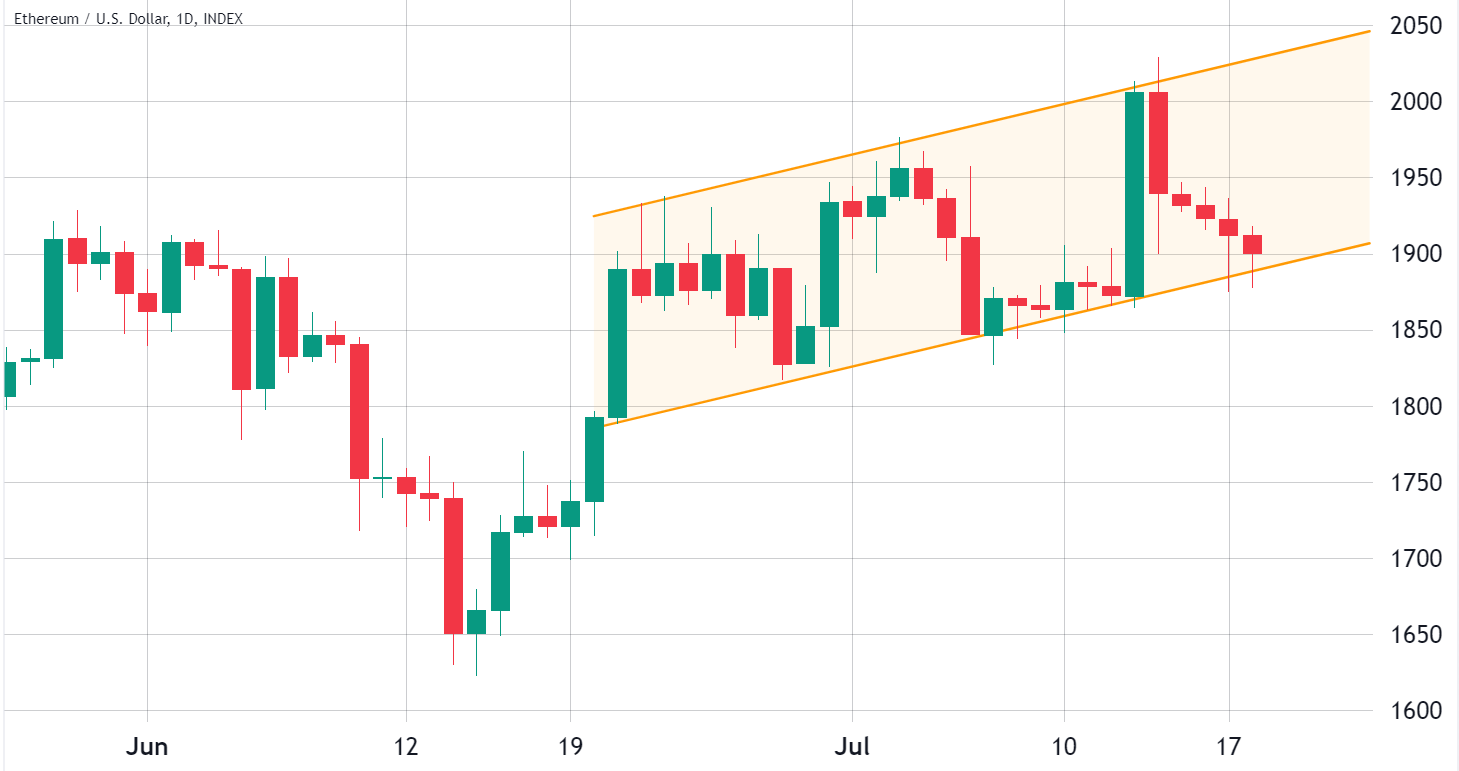Fidelity Digital Assets đã phát hành “Báo cáo tín hiệu quý 2/2023” vào ngày 18/7, trong đó đề cập đến triển vọng của ETH trong 12 tháng tới và dài hạn là tích cực. Từ đầu năm đến nay, ETH tăng 62%, nhưng tuy công ty đầu tư có thể tăng giá ngắn hạn đối với ETH, điều đó không có nghĩa là họ tin rằng kênh tăng giá kéo dài 1 tháng sẽ được duy trì.
Mặc dù các nhà đầu tư tổ chức như Fidelity Digital Assets có tầm nhìn lạc quan dài hạn hơn về giá của ETH, nhưng hãy so sánh phân tích của họ với dữ liệu mạng và thị trường để xem liệu họ có đúng hay không.

Chỉ số giá ETH 1 ngày | Nguồn: TradingView
Ngoài các chỉ báo kỹ thuật, lý do cho triển vọng tăng giá của Fidelity đối với ETH là tốc độ đốt của mạng cao hơn so với phát hành coin, “động lực địa chỉ mới” và số lượng trình xác thực mạng tăng.

“Báo cáo tín hiệu quý 2/2023” của Fidelity | Nguồn: Fidelity Digital Assets
Theo báo cáo của Fidelity, phát hành ròng kể từ The Merge vào tháng 9/2022 dẫn đến nguồn cung ròng giảm hơn 700.000 ETH. Ngoài ra, các nhà phân tích cho rằng dữ liệu Glassnode thể hiện số lượng địa chỉ Ethereum được giao dịch lần đầu tiên ngày càng tăng chứng tỏ chấp nhận mạng lành mạnh.
Báo cáo cũng chỉ ra số lượng trình xác thực Ethereum đang hoạt động tăng 15% trong quý hai.
Kỳ vọng về EIP-1153 cũng đang tạo đà cho mạng Ethereum, vì “opcode lưu trữ tạm thời” cải thiện hiệu quả hợp đồng thông minh, giảm chi phí và khuếch đại thiết kế Ethereum Virtual Machine. Theo dữ liệu của DefiLlama, sự thay đổi này đặc biệt có ý nghĩa đối với các sàn giao dịch phi tập trung (DEX), nơi mà tỷ lệ thống trị của Ethereum giảm xuống 46% từ 60% 6 tháng trước đó.
Nâng cấp Dencun dự kiến sẽ giảm chi phí giao dịch
Một yếu tố tăng giá tiềm năng khác cho Ethereum là dự kiến nâng cấp trên DEX hàng đầu Uniswap. Theo bài thuyết trình ngày 17/7 tại Ethereum Community Conference, Uniswap v4 sắp tới sẽ cho phép người dùng xây dựng các loại pool không giới hạn bằng cách sử dụng các nút (móc) có thể lập trình, hỗ trợ ETH gốc và hợp đồng đơn lẻ thực hiện giao dịch nội bộ trước khi thanh toán số dư cuối cùng.
Thông báo này đã thúc đẩy khả năng EIP-1153 sẽ được đưa vào bản nâng cấp “Dencun” tiếp theo. Nếu được chấp thuận, việc triển khai sẽ rất quan trọng đối với mạng Ethereum để lấy lại thị phần bị mất do phí gas cao, vì chi phí giao dịch trung bình trong 7 ngày ở mức trên 4 đô la kể từ tháng 2. Hậu quả là tổng giá trị bị khóa của Ethereum giảm xuống mức thấp nhất kể từ tháng 4/2020, ở mức 13,55 triệu ETH, theo DefiLlama.
Hơn nữa, hoạt động của ứng dụng phi tập trung giảm dần, thể hiện qua dữ liệu 30 ngày của các ví hoạt động duy nhất từ DappRadar: Uniswap -28%, 1inch Network -14%, MetaMask Swap -8% và OpenSea -5%. Để so sánh, trong cùng thời gian, PancakeSwap của BNB Chain tăng 10% và người dùng Uniswap trên Polygon tăng 8%.
Chỉ số phái sinh vẫn không thay đổi
Hợp đồng tương lai ETH hàng quý báo hiệu sự bất an của các trader chuyên nghiệp. Các hợp đồng tháng cố định đó thường giao dịch ở mức chênh lệch cao hơn từ 5% đến 10% so với thị trường giao ngay để bù đắp cho việc trì hoãn thanh toán, một tình huống được gọi là bù hoãn mua.
Phí chênh lệch hợp đồng tương lai ETH 3 tháng | Nguồn: Laevitas
Theo dữ liệu từ Laevitas, phí chênh lệch hợp đồng tương lai 3 tháng của ETH hiện ở mức 4%, thấp hơn ngưỡng trung lập và thấp hơn mức 5,5% được thấy vào ngày 14/7. Chỉ báo này là bằng chứng rõ ràng cho thấy các trader ít có khuynh hướng sử dụng đòn bẩy hơn cho các vị trí ETH tăng giá.
Đáng lo ngại hơn, mức tăng 59% của ETH từ đầu năm đến nay có thể khiến các nhà đầu tư trở nên quá lạc quan. Một cuộc khảo sát gần đây từ CryptoVantage với 1.000 người Bắc Mỹ đã đầu tư vào tiền điện tử trong 5 năm qua ghi nhận 46% khẳng định ETH là đối thủ hàng đầu để vượt qua Bitcoin.
Các coin có cơ hội tốt nhất để vượt qua Bitcoin | Nguồn: Khảo sát CryptoVantage năm 2023
Đây là một quan điểm hơi đáng ngạc nhiên, nhưng nó có thể gây hiểu nhầm vì cuộc khảo sát không đặt câu hỏi liệu có coin nào cuối cùng sẽ lật Bitcoin hay không, vì vậy những người được hỏi không nhất thiết trả lời chính xác cho kết quả này.
Phân tích của Fidelity đã đưa ra những lý do hợp lệ giải thích tại sao công ty lạc quan về hiệu suất giá trong 12 tháng của ETH, nhưng trong ngắn hạn, phí gas cao liên tục và người mua không quan tâm đến đòn bẩy báo hiệu rủi ro giá ETH phá vỡ dưới mức hỗ trợ của kênh tăng dần.
Bạn có thể xem giá các đồng coin ở đây.
Đình Đình
Theo Cointelegraph
